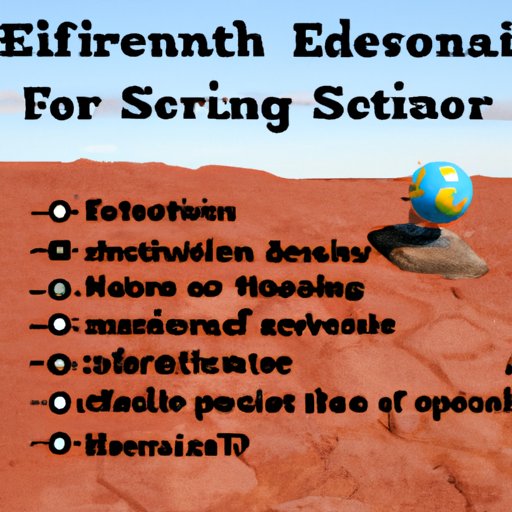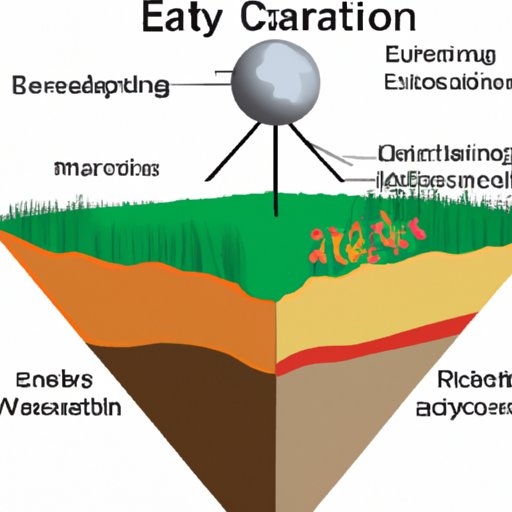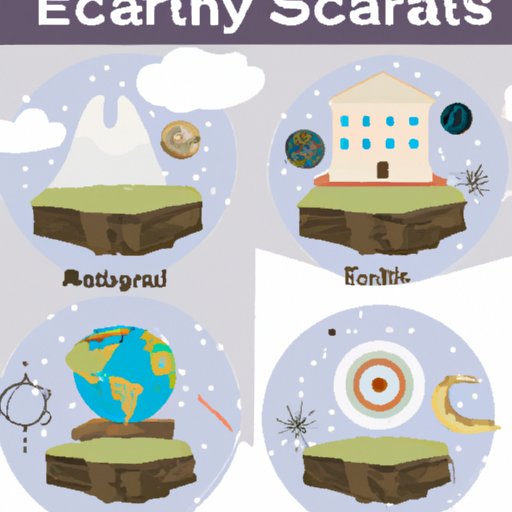Introduction
Earth science is the study of the Earth and its components, including its atmosphere, hydrosphere, lithosphere, and biosphere. It is an interdisciplinary field that incorporates aspects of physics, chemistry, biology, geography, and mathematics. In high school, earth science is typically taught as a single course or as part of a larger science curriculum. This article will explore the various branches of earth science, their relevance to high school education, and the benefits of understanding them.
Exploring the Branches of Earth Science and Their Relevance to High School Education
Earth science encompasses several different disciplines, each of which can be studied in high school. These include geology, oceanography, meteorology, and astronomy.
Geology
Geology is the study of the Earth’s physical structure and composition, as well as its history and processes. In high school, students may learn about topics such as plate tectonics, mineralogy, volcanology, sedimentology, and stratigraphy. They may also explore the formation and evolution of the solar system, the origin of life on Earth, and the effects of natural disasters.
Oceanography
Oceanography is the study of the world’s oceans and their interaction with other Earth systems. In high school, students may learn about ocean circulation, marine organisms, and the ecology of coastal areas. They may also explore topics such as tides, waves, and weather patterns at sea.
Meteorology
Meteorology is the study of the Earth’s atmosphere, including its composition and dynamics. In high school, students may learn about the physics of the atmosphere, climate change, and the effects of air pollution. They may also explore topics such as weather forecasting, cloud formation, and extreme weather events.
Astronomy
Astronomy is the study of the universe beyond Earth, including stars, planets, galaxies, and other celestial objects. In high school, students may learn about the structure and constituents of the universe, the theory of relativity, and the search for extraterrestrial life. They may also explore topics such as black holes, cosmology, and the origin of the universe.

Benefits of Understanding Earth Science for High School Students
Understanding earth science can provide high school students with numerous benefits. Research suggests that students who take earth science courses tend to perform better on standardized tests and have increased knowledge of environmental issues. Additionally, learning about earth science can help students develop better problem-solving skills and gain a better understanding of the world around them.
Improved Problem-Solving Skills
According to a study conducted by the National Center for Education Statistics, students who took earth science courses scored higher on problem-solving tests than those who did not. The study found that students who had taken earth science courses were better able to identify problems, analyze data, and draw conclusions from their findings. This suggests that taking earth science courses can help high school students develop their problem-solving skills.
Increased Knowledge of Environmental Issues
Earth science courses can also help high school students gain a better understanding of environmental issues. By learning about topics such as climate change and air pollution, students can become more aware of the challenges facing our planet and the steps we can take to address them. Having this knowledge can help students make informed decisions about their own actions and those of their communities.
Better Understanding of the World Around Us
Finally, studying earth science can help students gain a better understanding of the world around them. By exploring topics such as plate tectonics, ocean circulation, and climate change, students can gain insight into the forces that shape our planet and the ways in which human activity affects it. This knowledge can help students make more informed decisions about their lives and the future of our planet.

How Earth Science Can Be Applied to Everyday Life
Earth science can also be applied to everyday life in a variety of ways. Knowing about topics such as weather patterns and natural disasters can help us make better decisions about when to go outside and how to prepare for emergencies. Additionally, understanding resource management can help us make more sustainable choices about how we use energy and water.
Weather Predictions
Having an understanding of meteorology can help us make better decisions about when to go outside and what to wear. By looking at weather forecasts and analyzing satellite images, we can get a better idea of what the weather will be like in the coming days. This knowledge can help us plan our activities accordingly and ensure that we are properly prepared for any weather conditions.
Natural Disasters and Emergency Preparedness
Studying earth science can also help us prepare for natural disasters and other emergencies. By learning about topics such as earthquakes, floods, and hurricanes, we can better understand the risks associated with these events and how to prepare for them. Additionally, having an understanding of emergency response procedures can help us respond quickly and safely in the event of an emergency.
Resource Management
Finally, understanding earth science can help us make more sustainable choices about how we use resources. By learning about topics such as water conservation, energy efficiency, and renewable energy, we can better understand the impact of our actions on the environment and make more informed decisions about how to reduce our impact.

Preparing for Advanced Earth Science Courses in College
For high school students interested in pursuing advanced earth science courses in college, there are a few steps they can take to prepare. These include learning strategies, finding recommended resources, and selecting the right courses.
Learning Strategies
High school students can start preparing for college-level earth science courses by developing effective learning strategies. These may include reading and note-taking techniques, memorization strategies, and test-taking strategies. Additionally, students should practice working through problems on their own and seek help from their teachers when needed.
Recommended Resources
Students should also familiarize themselves with recommended resources for college-level earth science courses. These may include textbooks, online tutorials, and supplemental materials. Additionally, students should take advantage of any available tutoring or study group opportunities.
Course Selection
Finally, students should carefully select the courses they will take in college. While some schools may require certain courses, students should take the time to research the options available to them and choose the ones that best fit their interests and goals. Additionally, students should consider enrolling in courses outside of their major to broaden their knowledge and gain new skills.
Conclusion
In conclusion, earth science is an important subject to study in high school. It can provide students with numerous benefits, such as improved problem-solving skills, increased knowledge of environmental issues, and a better understanding of the world around them. Additionally, earth science can be applied to everyday life in a variety of ways, such as predicting the weather and understanding resource management. For high school students interested in pursuing advanced earth science courses in college, there are a few steps they can take to prepare, such as learning strategies, finding recommended resources, and selecting the right courses.
(Note: Is this article not meeting your expectations? Do you have knowledge or insights to share? Unlock new opportunities and expand your reach by joining our authors team. Click Registration to join us and share your expertise with our readers.)
